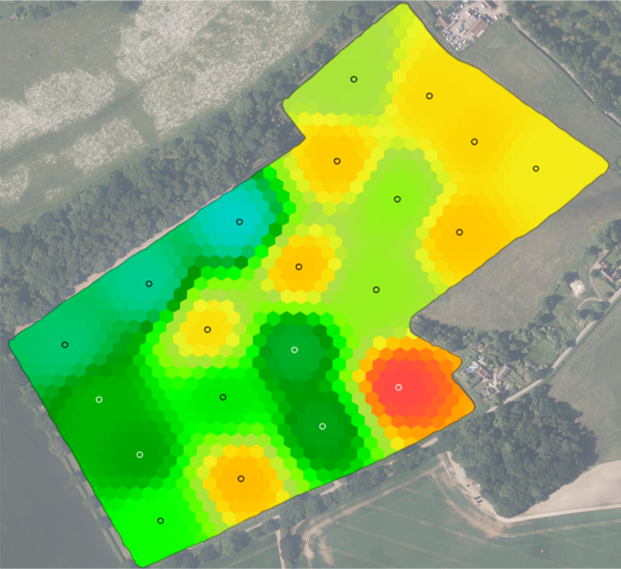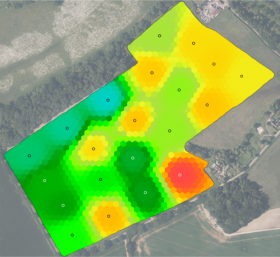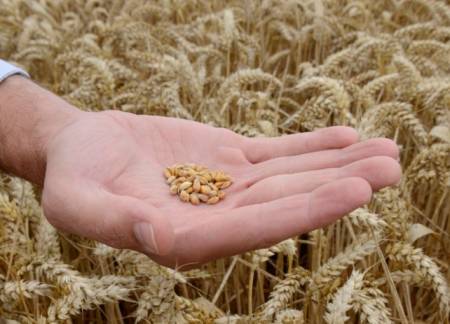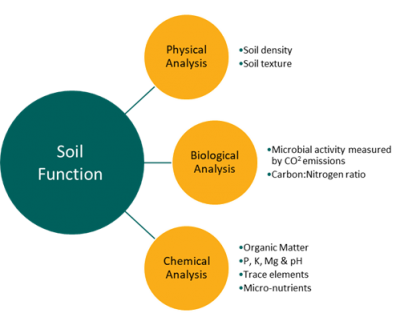Opportunities to make soil sampling pay
With a bullish global fertiliser market pushing prices up as we approach the new season, the importance of soil sampling to help optimise inputs is arguably greater than ever before. When you combine this with the recent Sustainable Farming Incentive (SFI) release stating growers can be financially rewarded for monitoring and improving soil health, it's not surprising to learn that sampling is becoming a greater priority.
With this in mind, let's look at how soil sampling could offer you a payback this season and in those to come.
Targeted inputs
Taking samples from a field in a 'W-pattern' is a simple and common method used by many to collect representative soil data.
However, while W-pattern sampling offers an insight into the average nutrient status of your field, by precision nutrient mapping you can see the variation within your field. The images below show the difference in results from precision nutrient mapping (left), in this instance one sample per hectare, and W-sampling (right). Both fields are approximately 21 hectares, but you can clearly see that the precision nutrient mapping has picked up a wide range of soil nutrient levels (magnesium in this case) across the 21 sample points, whereas the W-pattern has returned only one value for the whole field.
By understanding the variation, you can target your inputs exactly where they are required - whether from a bag, an animal, or another source – and this could offer a significant cost saving. Even those who aren't looking to use variable rate technology can manually apply inputs in areas that are in need, avoiding what could be a costly over-application particularly in this season. It's recommended to base your applications on the more detailed of the two maps, especially with the current fertiliser market.
If you think you might need to prioritise fields for fertiliser this year due to budget restrictions or shortened application windows, you can use your nutrient maps to ensure you are treating the 'hungriest' fields or areas to maintain crop performance and soil health.
Agronomic benefits
As well as the advantages mentioned for nutrient management and your back-pocket, there are significant agronomic benefits. Even before you think about targeting your nutrients, soil sampling can inform you of how much additional nutrition you need to provide. One of the biggest paybacks soil sampling offers is the management of soil pH, as getting it right is vital.
Having the correct pH supports more soil microbial diversity. If levels are wrong, plants can struggle to uptake nutrient no matter how much is available. Accurate soil sampling can identify any pH 'hotspots' before they have a negative impact on your crop, helping you to make potential savings by targeting your lime applications and reducing crop losses.
Yield benefits
Having discussed the agronomic benefits of taking a detailed approach to soil sampling, we can't ignore the potential yield benefit. The fact of the matter is, even a marginal gain in yield per hectare would easily cover the cost of any soil sampling especially with the current grain market. We know that any soils with insufficient nutrients are yield limiting but without detailed sampling it is easy to lose sight of these areas, meaning they will continue to perform below potential and underachieve.
Soil function
It's always worth remembering that when we discuss soil function and health, it is driven by three main areas as shown in the diagram. The chemical analysis and composition of your soil is crucial for supporting good biological conditions and creating resilient soil. I always encourage anyone who is looking at building soil health and function to ensure they have a good insight into the chemical status of their soil by having it sampled. For anyone looking to explore and better understand these three areas, Frontier's Soil Life service is a great solution.
Benchmarking & planning
Agriculture is a progressive industry and many farmers are constantly looking at making improvements to their farm management systems. My advice is, in the same way that you would assess the changes to your financial bottom line, you need to assess the changes to your soil baseline. Precision nutrient mapping your soils at the start of your journey means that you can return to the same points in four- or five years' time and see how your soils have changed from your benchmark level. When you come to your review, utilising MySOYL to align your environmental and crop production data together on one screen allows you to take a holistic approach to your assessments and future management.
Sustainable Farming Incentive
The recent details of the SFI pilot, which runs until 2024, placed a large emphasis on soil function and health - in particular the arable and horticultural land standard and arable and horticultural soils standard. Both offer the potential for significant opportunities, with growers likely to be rewarded for soil sampling and using the data in management decisions and activities.
In fact, all three tiers of the arable and horticultural land standard: Introductory, Intermediate and Advanced offer payments for actions which include soil sampling and nutrient management in some form. Some of the detail outlined for the pilot tiers so far includes:
Introductory – The entry level offers growers payments of £28/ha to deliver actions that include creating a nutrient management plan based upon soil sampling.
Intermediate – The mid-level offers payments of £54/ha for actions, one of which is to 'carry out soil mapping' to help better target nutrient applications.
Advanced – The final level offers payments of £74/ha, with one of the required actions being to 'apply fertilisers and pesticides with precision equipment'.
In fact, many growers who are already using SOYL's precision nutrient mapping will already be meeting the requirements above.
It's important to note that these are only draft proposals for the SFI pilot scheme and you are required to carry out additional actions at each level to receive the payments quoted. However, I think the mention of such activities gives us a clearer picture of future expectations. Looking in detail at your soils and employing precision nutrient management practices is being recognised and could be rewarded as part of future farm support schemes.
Optimise activity and improve your returns
The Government's position on soil function seems clear and when combined with the crop production benefits available, soil sampling and precision nutrient management offer real opportunities now and into the future.
While I understand that there is only a set number of growers involved in the SFI pilots at the moment, the current fertiliser market and wider benefits associated with targeting your inputs means there is still ample opportunity to make soil sampling pay for you and your business right now.
For more information about soil sampling and the best options for you, please speak to your local SOYL contact or get in touch.
As a subscriber, you’ll receive email alerts each time a new blog is published so you can always stay updated with the latest advice and insights from our experts







Comments